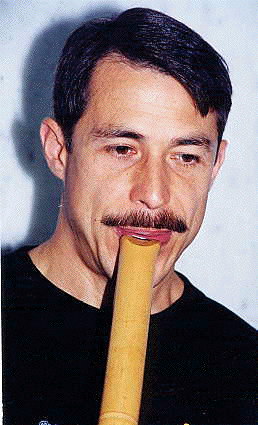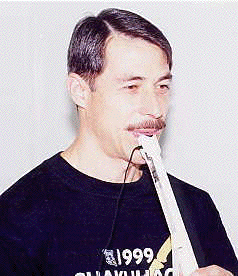ASA/NOISE-CON 2000
[ Lay Language Paper Index | Press Room ]
Some Acoustics of the Shakuhachi--
and of the Shakuhachi Player's Face
and of the Shakuhachi Player's Face
Joe Wolfe- J.Wolfe@unsw.edu.au
John Smith- jrs@newt.phys.unsw.edu.au
School of Physics, University of New South Wales
Sydney 2052 Australia
Popular version of paper 3aMU2
Presented Wednesday morning, 6
December 2000
ASA/NOISE-CON
2000 Meeting, Newport Beach, CA
Increased interest in non-European instruments has brought international attention to the shakuhachi or Japanese flute. This instrument is capable of great subtlety, having a wide range of sounds, and very flexible pitch. Although the instrument has only five finger holes, players can smoothly vary the pitch up and down to produce the notes of the Western scale - and all of the notes that fall in between. A player does this by changing the extent to which the upper lip and face cover the aperture across which they blow. This can be done by moving the lower jaw forward or back, and raising or lowering the instrument. To some extent this is possible in the Western transverse flute, but the effect is much greater on the shakuhachi because it is open at the blowing end, and so the acoustic baffling by the player's lips and face is more important. So in this research we measured the acoustic impedance of the instrument (alone, without a player) and the acoustic baffling of the player's face, as 'seen' by the instrument. Then we calculated the total response.
The instrument. Our laboratory specializes in the acoustics of the air-jet family of instruments, which includes flutes and recorders. Our measurement apparatus attaches to the instrument at the 'input', where the player would normally blow. We then inject an acoustic current (a specially synthesised flow of air) that simultaneously contains thousands of different frequencies. We use a microphone to measure the way the instrument responds to all the frequencies. Technically, we are measuring the acoustic impedance spectrum. The acoustic impedance is the ratio of sound pressure to varying air flow, and it varies strongly with frequency. Because shakuhachis and other flutes are open to the air at the mouthpiece, they operate at minima in the impedance: frequencies where small pressure differences can produce large flows in and out of the instrument. The frequencies of these minima determine what notes the instrument will play for a given fingering. The timbre of the sound produced depends (among other things) on the depths of these minima and how close they are to harmonic ratios. But we have first to correct these spectra for the instrument alone to include the acoustic baffling by the player's face.
The player's face. To measure this effect, we took a plastic shakuhachi and cut away part of it so that we could insert the measurement head of our spectrometer inside the shakuhachi. We thus measure the acoustics of the player's face, from the point of 'view' of the instrument. Riley Lee, a famous Shakuhachi player who is currently touring the US was the experimental subject. We measured the acoustic impedance of the radiation field, baffled by his lips and face, as he demonstrated the configuration used to blow normal notes, singly and doubly flattened notes, raised notes and various different timbres.
Using these data, we are able to display the acoustic response of the instrument plus player - esentially the acoustic situation that determines the behaviour of the jet of air which drives the instrument. The more that the player's lips and face obstruct the radiation from the input of the instrument, the lower the frequencies of the resonances. The results agree nicely with the amount by which players know they can flatten the pitch. We can also see effects which explain the different timbre of these notes.


Riley Lee (left) playing the shakuhachi and (right) having his acoustic baffling spectrum measured.
A collection of sound files illustrates pitch adjustment on single notes. There is also a small sample of shakuhachi music.
We are assembling a shakuhachi research site where we shall post scientific results from this study.
[ Basics | Research | Publications | People ]